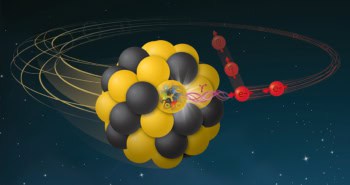The first of a new generation of meson factories was officially inaugurated in Italy at the end of September.
Called DAFNE, the accelerator will be used for a range of experiments in nuclear and particle physics. The facility at the Frascati National Laboratories cost about L100 bn (about £36 m) to build and some 150 physicists from all over the world will conduct experiments there.
DAFNE consists of an injection system and a collider, where electrons and positrons circulate in two separate rings at 0.51 GeV, before colliding in the two experimental areas to produce copious quantities of phi-mesons. These short-lived particles contain a strange quark bound to strange antiquark and decay rapidly into other lighter particles, notably kaons.
“DAFNE is the first of its kind worldwide, the first so-called factory, producing an abundant number of particles, ” says Paolo Laurelli, director of the Frascati laboratory. Higher energy machines producing B-mesons – so-called B-factories – are planned for the Stanford Linear Accelerator Center in California and at the KEK laboratory in Japan.
DAFNE will have three main experiments: KLOE, FINUDA and DEAR. The KLOE experiment will investigate the subtle differences between matter and antimatter found in the decay of neutral kaons – mesons that consist of a down quark and a strange antiquark or vice versa. When neutral kaons decay, they violate the CP theorem, which states that the physics of an interaction should not change if particles are replaced by their antiparticles and the interaction is reflected in a mirror. Studies of CP violation could help explain why the universe is dominated by matter rather than antimatter.
The FINUDA magnetic spectrometer will study what happens when an ordinary nucleon composed of up and down quarks – such as a proton or neutron – is replaced by a baryon containing a strange quark.
The object of DEAR is to produce “unnatural” atoms by replacing one electron in an ordinary atom with a kaon. Spectroscopic study of such atoms could lead to a better understanding of strong interactions and provide more accurate tests of quantum chromodynamics at low energies.
Experiments on DEAR are due to begin next summer, with both KLOE and FINUDA taking data by the end of 1998. At a later date, the facility could also be used to provide intense synchrotron radiation in the ultraviolet and soft X-ray range.



